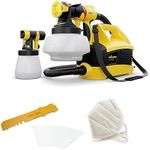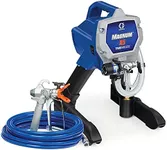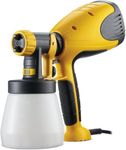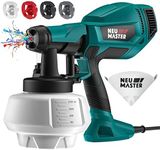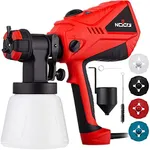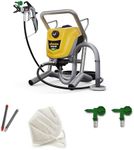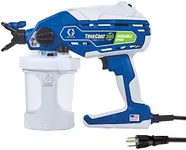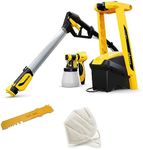Buying Guide for the Best Indoor Paint Sprayers
Choosing the right indoor paint sprayer can make your painting projects more efficient and provide a professional finish. When selecting a paint sprayer, consider the type of projects you will be undertaking, the frequency of use, and the types of paint you plan to use. Understanding the key specifications will help you make an informed decision that suits your needs and ensures a smooth painting experience.Type of SprayerThere are three main types of paint sprayers: airless, HVLP (High Volume Low Pressure), and compressed air sprayers. Airless sprayers are powerful and suitable for large surfaces and thick paints, making them ideal for exterior walls or large indoor spaces. HVLP sprayers are better for detailed work and fine finishes, such as furniture or cabinetry, as they provide more control and less overspray. Compressed air sprayers are less common for indoor use but can be used for a variety of finishes. Choose based on the scale and detail of your projects.
Power SourcePaint sprayers can be powered by electricity, batteries, or air compressors. Electric sprayers are convenient for indoor use as they provide consistent power and are easy to set up. Battery-powered sprayers offer more mobility and are suitable for smaller projects or areas without easy access to power outlets. Air compressor-powered sprayers require an external compressor, which can be cumbersome but offers versatility in pressure control. Consider your workspace and mobility needs when choosing the power source.
Spray Tip SizeThe spray tip size determines the width and thickness of the paint application. Smaller tips (e.g., 0.009 to 0.013 inches) are suitable for thin materials like stains and lacquers, while larger tips (e.g., 0.015 to 0.021 inches) are better for thicker paints like latex. If you plan to use a variety of paints, look for a sprayer with interchangeable tips. Choose a tip size based on the type of paint you will use most frequently and the surface area you need to cover.
Paint CapacityThe paint capacity of a sprayer refers to how much paint it can hold at one time. Larger capacity sprayers are ideal for big projects as they reduce the need for frequent refills, while smaller capacity sprayers are lighter and easier to handle, making them suitable for detailed work or smaller areas. Consider the size of your projects and your comfort with handling the sprayer when choosing the paint capacity.
Adjustable PressureAdjustable pressure allows you to control the flow of paint, which is crucial for achieving different finishes and working with various paint types. Higher pressure is useful for covering large areas quickly, while lower pressure is better for detailed work and reducing overspray. If you plan to work on a variety of projects, look for a sprayer with adjustable pressure settings to give you more flexibility and control.
Ease of CleaningPaint sprayers require thorough cleaning after each use to maintain performance and longevity. Some models offer features like easy disassembly or special cleaning modes that simplify the process. Consider how often you will use the sprayer and your willingness to spend time on maintenance when evaluating ease of cleaning. A sprayer that is easy to clean will save you time and effort in the long run.


